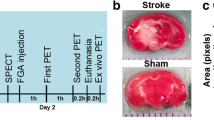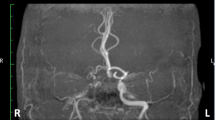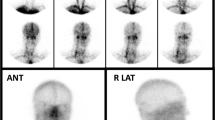Abstract
Technetium-99m hexamethylpropylene amine oxime (99mTc HMPAO) brain single photon emission computed tomography (SPECT) was used to evaluate the effects of anticoagulant therapy (ACT) on regional cerebral blood flow (rCBF) in patients with primary antiphospholipid antibody syndrome (PAPS). Sixteen female PAPS patients with neuropsychiatric manifestations and hypoperfusion lesions demonstrated on initial 99mTc HMPAO brain SPECT images were enrolled in this study. Follow-up 99mTc HMPAO brain SPECT images were performed 1 month after ACT. Meanwhile, serum anticardiolipin antibodies (ACA) were measured before and after ACT. Before ACT, 14 (87.5%) patients had positive ACA. After ACT, all 16 PAPS patients showed decreased serologic findings, and their neuropsychiatric manifestations subsided . After ACT, 11 (68.8%) patients showed complete recovery of regional cerebral blood flow (rCBF) and five (31.2%) patients showed partial recovery in the follow-up 99mTc HMPAO brain SPECT images. This type of imaging is a logical and objective tool for measuring the effects of ACT in PAPS patients with brain involvement by determining changes in rCBF.

Similar content being viewed by others
References
Harris EN (1987) Syndrome of the black swan. Br J Rheumatol 26:324–327
Harris N (1994) Antiphospholipid syndrome. In: Klippel JH, Dieppe P (eds) Rheumatology. Mosby, St. Louis 6:32.1–32.6
Goel N (1985) Antiphospholipid antibody syndrome: current concepts. Hosp Pract 15:129–149
Petri M (1997) Pathogenesis and treatment of the antiphospholipid antibody syndrome. Med Clin N Am 81:151–177
Rosenbaum RB, Campbell SM, Rosenbaum JT (1996) The primary anti-phospholipid antibody syndrome. In: Rosenbaum RB, Campbell SM, Rosenbaum JT (eds) Clinical neurology of rheumatic diseases. Butterworth-Heinemann, Newton, pp 219–223
Khamashta MA, Cuadrado MJ, Mujic F, Taub NA, Hunt BJ, Hughes GR (1995) The management of thrombosis in the antiphospholipid-antibody syndrome. N Engl J Med 332:993–997
Levine SR, Brey RL, Joseph CL, Havstad S (1992) Risk of recurrent thromboembolic events in patients with focal cerebral ischemia and antiphospholipid antibodies. The Antiphospholipid Antibodies in Stroke Study Group. Stroke 23 [Suppl 2]:29–32
Weingarten K, Filippi C, Barbut D, Zimmerman RD (1997) The neuroimaging features of the cardiolipin antibody syndrome. Clin Imaging 21:6–12
Cervera R, Asherson RA, Font J, Tikly M, Pallares L, Chamorro A, Ingelmo M (1997) Chorea in the antiphospholipid syndrome. Clinical, radiologic, and immunologic characteristics of 50 patients from our clinics and the recent literature. Medicine (Baltimore) 76:203–212
Macucci M, Dotti MT, Battistini S, De Stefano N, Vecchione V, Orefice G, Malandrini A, Federico A (1994) Primary antiphospholipid syndrome: two case reports, one with histological examination of skin, peripheral nerve and muscle. Acta Neurol Napoli 16:87–96
Angelini L, Rumi V, Nardocci N, Combi ML, Bruzzone MG, Pellegrini G (1993) Hemidystonia symptomatic of primary antiphospholipid syndrome in childhood. Mov Disord 8:383–386
Molad Y, Sidi Y, Gornish M, Lerner M, Pinkhas J, Weinberger A (1992) Lupus anticoagulant: correlation with magnetic resonance imaging of brain lesions. J Rheumatol 19:556–561
Kato T, Morita A, Matsumoto Y (1997) Hypoperfusion of brain single photon emission computerized tomography in patients with antiphospholipid antibodies. J Dermatol Sci 14:20–28
Kato T, Nanbu I, Tohyama J, Ohba S (1995) Evaluation of cerebral perfusion imaging with N-isopropyl-p-[123I]iodoamphetamine (IMP) in the cases of antiphospholipid syndrome. Kaku Igaku 32:31–40
Kao CH, Lan JL, Hsieh JF, Ho YJ, ChangLai SP, Lee JK, Ding HJ (1999) Evaluation of regional cerebral blood flow with 99mTc-HMPAO in primary antiphospholipid antibody syndrome. J Nucl Med 40:1446–1450
Szpak GM, Kuczynska-Zardzewialy A, Popow J (1996) Brain vascular changes in the case of primary antiphospholipid syndrome. Folia Neuropathol 34:92–96
Hughson MD, McCarty GA, Sholer CM, Brumback RA (1993) Thrombotic cerebral arteriopathy in patients with the antiphospholipid syndrome. Mod Pathol 6:644–653
Westerman EM, Miles JM, Backonja M, Sundstrom WR (1992) Neuropathologic findings in multi-infarct dementia associated with anticardiolipin antibody. Evidence for endothelial injury as the primary event. Arthritis Rheum 35:1038–1041
Kao CH, Ho YJ, Lan JL, Changlai SP, Liao KK, Chieng PU (1999) Discrepancy between regional cerebral blood flow and glucose metabolism of brain in SLE patients. Arthritis Rheum 42:61–68
Kao CH, Ho YJ, Lan JL, ChangLai SP, Chieng PU (1998) Regional cerebral blood flow and glucose metabolism in Sjögren syndrome. J Nucl Med 39:1354–1356
Kao CH, Lan JL, ChangLai SP, Chieng PU (1998) Tc-99m HMPAO SPECT and MRI of brain in neuro-Behçet's patients. J Nucl Med 39:1707–1710
Kao CH, Lan JL, ChangLai SP, Chieng PU (1998) Tc-99m HMPAO brain SPECT in Sjögren's syndrome patients. J Nucl Med 39:773–777
Hellman RS, Tikofsky RS, Van Heertum R, Coade G, Carretta R, Hoffmann RG (1994) A multi-institutional study of interobserver agreement in the evaluation of dementia with rCBF/SPET technetium-99m exametazime (HMPAO). Eur J Nucl Med 21:306–313
Ho SS, Berkovic SF, Berlangieri SU, Newton MR, Egan GF, Tochon-Danguy HJ, McKay WJ (1995) Comparison of ictal SPECT and interictal PET in the presurgical evaluation of temporal lobe epilepsy. Ann Neurol 37:738–745
Pasquier F, Lavenu I, Lebert F, Jacob B, Steinling M, Petit H (1997) The use of SPECT in a multidisciplinary memory clinic. Dement Geriatr Cogn Disord 8:85–91
Hughson MD, McCarty GA, Sholer CM, Brumback RA (1993) Thrombotic cerebral arteriopathy in patients with the antiphospholipid syndrome. Mod Pathol 6:644–653
Author information
Authors and Affiliations
Corresponding author
Rights and permissions
About this article
Cite this article
Sun, S.S., Liu, F.Y., Tsai, J.J.P. et al. Using 99mTc HMPAO brain SPECT to evaluate the effects of anticoagulant therapy on regional cerebral blood flow in primary antiphospholipid antibody syndrome patients with brain involvement—a preliminary report. Rheumatol Int 23, 301–304 (2003). https://doi.org/10.1007/s00296-003-0314-3
Received:
Accepted:
Published:
Issue Date:
DOI: https://doi.org/10.1007/s00296-003-0314-3




